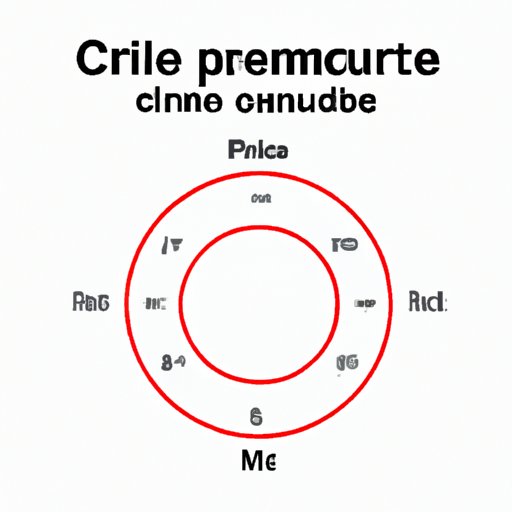
I. Introduction
Knowing how to find the perimeter of a circle is an essential piece of knowledge that can be useful in many real-world situations, such as construction, architecture, and engineering. The perimeter, also known as the circumference, is the distance around the circle. This article will guide you through the process of finding the perimeter of a circle in a clear and concise manner, using formulas, examples, and real-world applications.
II. Step-by-Step Guide
The formula for finding the perimeter of a circle is P = 2πr, where P represents perimeter, and r represents the radius of the circle. First, it is necessary to determine the value of the radius, using the formula:
r = d/2, where d represents the diameter of the circle.
Once the radius is determined, simply plug it into the formula for perimeter, P = 2πr. For example, let’s find the perimeter of a circle with a radius of 5:
r = 5
P = 2π(5)
P = 10π, or approximately 31.42 units
It’s important to note that the value of π is a constant that equals approximately 3.14, but it should be used in calculations in its exact form, as it can cause significant errors if rounded to a smaller value.

Real-world applications of perimeter calculations include calculating the distance around a race track, the length of a wire needed to wrap a circular object, the distance traveled by a wheel per turn, and many others.
III. Tips and Tricks
Calculating the diameter of the circle is useful, as it is needed to find the radius and perimeter. If only the diameter is given, simply divide it by 2, as shown in the formula above.
Using a compass to draw the circle is recommended to obtain more accurate results. Place the needle point of the compass on the center of the circle, and rotate the pencil around it, keeping the distance between them constant, equal to the radius of the circle.
Some shortcuts that can be used to make the calculation process faster include rounding the value of π to 3, which will result in a slight underestimate, and using pre-calculated values for commonly used radii, such as 1, 2, or 5 units.
IV. Common Mistakes
One of the most common mistakes when finding the perimeter of a circle is using the diameter instead of the radius in the formula, or vice versa. Be sure to double-check the desired value before proceeding with the calculation.
Another mistake that can cause significant errors in the result is using an incorrect value of π, or rounding it too soon. Always use the exact value, or a sufficiently precise approximation, in calculations.
Examples of correcting these mistakes include using the formula r = d/2 to find the radius if the diameter is given instead of the radius, or rounding the final result to a reasonable number of decimal places, given the precision of the input values and the desired accuracy of the output.
V. Comparative Analysis
Using the diameter to find the perimeter of the circle is faster than using the radius, as it only requires dividing the diameter by 2, instead of multiplying the radius by 2π. However, the value of the radius is often easier to measure or visualize than the diameter, and it is more commonly used in formulas and calculations.
The units of measurement used for the diameter and radius should be consistent with the units of measurement used for the result of the perimeter. For example, if the diameter is given in meters, and the result is desired in centimeters, a conversion factor of 100 should be used to multiply the value of the perimeter obtained with the formula.
Circle perimeter calculations have been studied since ancient times, and have led to the development of various formulas and theorems, such as Archimedes’ approximation of π, or the relationship between the perimeter and the area of the circle.
VI. Real-World Applications
The importance of finding the perimeter of a circle is evident in many fields, such as engineering, construction, and architecture. For example, calculating the perimeter of a circular pipe can help determine the amount of material required for its construction, or the length of cable needed for its installation. Similarly, knowing the perimeter of a circular building can aid in estimating the amount of paint or other finishing materials needed for its exterior.
Other examples include measuring the distance around circular transportation infrastructures, such as airports or train stations, and designing circular spaces and structures that maximize their usage and accessibility.
VII. Conclusion
In conclusion, finding the perimeter of a circle is a useful skill that can be applied in various contexts and professions. By following the simple steps and tips outlined in this article, you can confidently calculate the perimeter of any circle, whether for practical or academic purposes.





